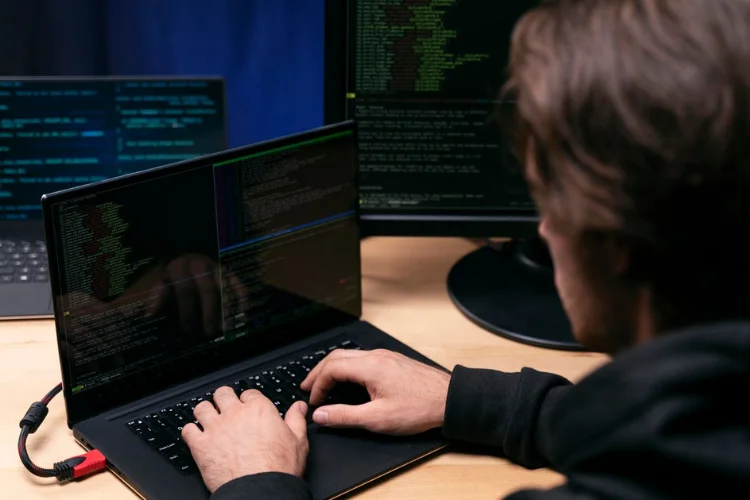What is Ransomware?
Ransomware represents a sophisticated form of malware that uses encryption to hold a victim’s data hostage. This malicious software targets both individuals and their devices, creating a significant threat. But what sets ransomware apart from other types of malwares? The answer lies in its unique method of operation and the havoc it can wreak.

The term “ransom” is a clear indication of this malware’s purpose. Ransomware functions as extortion software, effectively locking users out of their organizational files, databases, or even applications. By withholding access, it forces victims into a position where they must pay to regain control, making it a formidable threat in the digital age.
The effects of a ransomware attack are quick to spread across the network and paralyze an entire organization. If you want to be cyber smart, this article provides insights into the operational pattern of ransomware, its types, and the potential ways to minimize this risk. Let’s explore this key topic.
Why Ransomware is a Major Threat
Table of Contents
- Double- Extortion: It comes with the threat of stealing the victim’s vulnerable information and exposing it online.
- Triple-Extortion: It involves the misuse of stolen data to affect the victim’s clientele or business partners.
- These attacks quickly affect the device.
- When hackers gain complete control of a network, it takes them less than four days to deploy ransomware.
- Hackers give little time to detect and defeat potential attacks.
- Threat actors demand seven and eight-figure amounts and the payments are part of the total cost of ransomware infection.
- According to the data breach report, the cost of a ransomware breach is almost US 5.6 million dollars per incident.
What are the Forms of Ransomware?
The variant of the virus defines the gravity of the ransomware threat. Let’s consider the two prime categories of ransomware to help you walk through the threat level. These can be easily distinguished as follows.
Crypto Ransomware
In this form, the cyber hacker encrypts the individual data files for evil ransom purposes.
Locker Ransomware
It involves freezing the basic device (computer) or app functions to access the sensitive information.
How Does Ransomware Infect a Device or a System?
If your device is infected with ransomware, the durable solution lies under thorough inspection of ways contributing to its occurrence and propagation. Ransomware operates by leveraging asymmetric encryption. This method is more pronounced than cryptography. It uses a strong pair of keys to smartly encrypt and decrypt a file.
- Hackers generate a public-private pair of keys for the victim.
- The private key is to decrypt the sensitive files saved on the server of the attacker.
- The private key remains on standby and is only used by the hacker after the ransom amount is paid.
- Without a private key, decrypting the files that are being held for ransom is nearly impossible.
- Ransomware attacks stay on an endpoint in the form of malware until its target is accomplished.
- After a successful exploit, a malicious binary is dropped and executed on the infected system. It searches and encrypts vulnerable files, documents, databases, images and more.
- Once all the targeted files are encrypted, hackers threaten the user for a ransom within the stipulated time frame for successful file decryption. Otherwise, all the files will be lost forever.
This is how ransomware works against the victim. Some of the infection-causing vectors are listed below for further insights.
Social Engineering Attacks
Different social engineering attacks including Phishing emails containing malicious attachments lure the users that end up in ransomware attacks. These attachments can be malicious QR codes or malicious website links.
OS and Software Vulnerabilities
Zero-day vulnerabilities either unknown to the security team or not patched yet even after identification can pose a serious threat. The malicious codes can easily exploit network or software devices.
Sensitive Credential Theft
Using brute-force attacks helps cyber criminals crack the credentials of authorized users or buy them on the dark web. These credentials are used for logging into a network system or a computer device to deploy ransomware directly. A proprietary Microsoft protocol is Remote Desktop Protocol (RDP) and it is a favorite credential threat target by ransomware criminals.
Drive-by-Downloads
Hackers pass vulnerable websites to users’ devices without their knowledge to inject ransomware. Adding more to it, Malvertising a form of legit digital ads is disguised by ransomware hackers to infect the devices with ransomware.
What are the Notable Ransomware Variants?
With digital advancement, distinct ransomware variants have also come to the surface. Cyber security researchers have identified malware attacks leading to ransomware and some variants with their own functions and code signatures. These variants are notable for the extent of their impact and ready to catch your attention by choice. All these variants significantly target encrypting sensitive files, networks, and devices.
- WannaCry
- Ryuk
- Maze Ransomware
- Wiper Malware
- LockBit
- Locky
- Darkside
How to Protect and Defend Ransomware Attacks?
There are different anti-ransomware solutions encompassing effective data backups, least privilege access, network segmentation and more. To avoid ransomware attacks and mitigate the damage extent, proper preparation is necessary to dramatically reduce the cost and impact of a ransomware attack. In the contemporary cyber scenario, ransomware challenges in IT solutions including budget, regulatory gaps, technical complexities, awareness deficiencies and more are crucial to address before expecting full-scale results of implementing protective measures.
- Endpoint Data Encryption Security: Ensure a safety measure ready to protect data on different devices from unauthorized access. The endpoint encryption can make the code unreadable.
- Effective Email Security Against Ransomware: Use secure emails and lean on email encryption policy using the MFA method, mail attachment scanning, and strong password option.
- Use Safe Check Point Software: A secure checkpoint software provides network and cloud solutions. It ensures checkpoint VPN clients and safe workplaces.
- Practice Secure Surfing: Allow only trusted and safe websites to become a part of your search history. Use safe browsing practices and block third-party cookies.
- Ensure Penetration Testing Insights for Ransomware Mitigation: Use pen testing to timely identify the vulnerable and weak credentials that may allow ransomware actors to gain unauthorized access.
- Data Backups and Regular Patching: Restore your sensitive files, documents, cloud data and network details through regular data backups and patching techniques.
- Employ User Authentication: Implement a user authentication process to verify the user’s identity before providing access to an organization’s cloud data, networks or physical facilities.
- Deliver Awareness Courses: Provide cyber security training programs to your team through simulation training, and awareness courses. These training courses are worthy of the hype.
- Stay Informed About Latest Ransomware Threats: Ransomware groups surged by 33% in 2024. Cybersecurity teams need to stay updated about the latest threat releases for potential mitigation of damage extent.
What is Ransomware-as-a-Service (RaaS)?
Cybercriminals have not to develop their ransomware to freely exploit these vectors. Different ransomware developers are ready to share their ransomware code with cybercriminals through Ransomware-as-a-Service (RaaS) arrangements. The cyber attacker leverages the code to carry out an attack and decides the ransom payment with the developer. It’s a two-way beneficial relationship as affiliates earn profit from extortion without creating their own ransomware malware. Developers can easily multiply their profit this way.
Do you know about ransomware distributors? Digital marketplaces provide them a platform to sell their ransomware malware on the dark web. They can even recruit affiliates through different online forums and this is how ransomware markets flourish.
What Should be the Next Move?
Ransomware is a significant threat in all forms and variants. Whether you are a private user or a corporate setup, keeping an eye on every threat it poses is paramount of importance. Be prepared for the eventualities but the most essential aspect is to learn about ransomware threats. Install the best security software or get assistance from advanced IT firms for effective configuration and cybersecurity solutions. Let’s enable the employees to work safely in a secure environment without compromising on productivity and quality scales.
Facing IT Challenges in Chicago?
Schedule a consultation with our expert team to get the help you need!
Related Articles

Importance of Endpoint Security Management

Improve Responsiveness of IT Support


